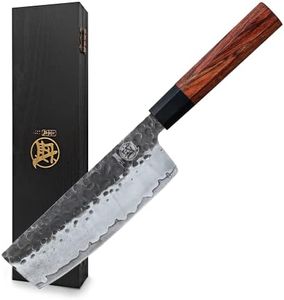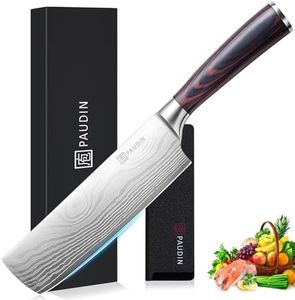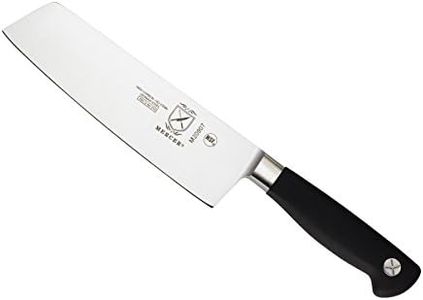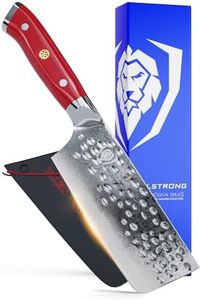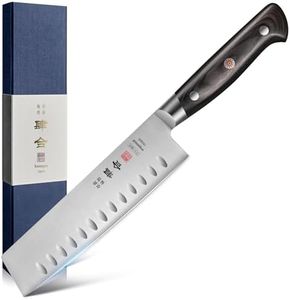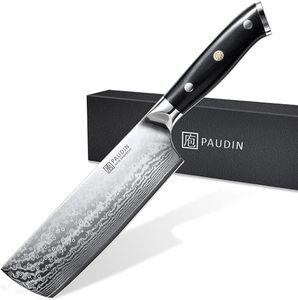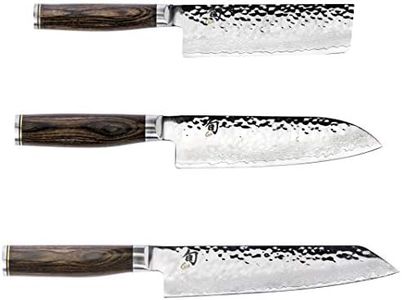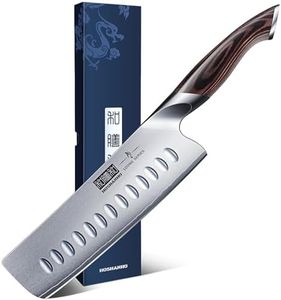We Use CookiesWe use cookies to enhance the security, performance,
functionality and for analytical and promotional activities. By continuing to browse this site you
are agreeing to our privacy policy
10 Best Nakiri Knives
From leading brands and best sellers available on the web.Buying Guide for the Best Nakiri Knives
Nakiri knives are a traditional Japanese vegetable knife, prized for their straight-edge blade which makes them especially good at slicing, dicing, and chopping produce. The flat edge provides clean cuts all the way down to the cutting board, making them ideal for home cooks focused on preparing fresh vegetables. When choosing a Nakiri knife, it’s important to balance comfort, blade quality, and your own cooking habits to ensure the knife truly becomes a helpful tool in your kitchen.Blade MaterialThe blade material refers to what the knife is made from, often stainless steel, high-carbon steel, or even ceramic. This is important because it affects sharpness, durability, rust resistance, and maintenance. Stainless steel is popular for ease of care and good edge retention, high-carbon steel is favored for its exceptional sharpness but needs more maintenance to avoid rust, and ceramic is lightweight and stays sharp a long time but can chip easily. If you want minimal upkeep, stainless steel is best; if you want a sharper edge and are willing to maintain it, high-carbon steel might suit you; ceramic fits those who want lightweight and rarely sharpen.
Blade LengthBlade length is measured from the handle to the tip, with Nakiri knives usually ranging from about 5 to 7 inches. This is key because it determines how easily you can handle large versus small vegetables and how comfortable the knife feels in your hand. Shorter blades (around 5 inches) are easier for precision work and for those with smaller hands or who do light veggie prep. Longer blades (6 to 7 inches) are better for tackling big vegetables or large quantities at once. Consider how much space you have to work and the types of vegetables you prepare most often.
Handle Design and MaterialHandle design and material determine how the knife feels and balances in your hand. Handle shapes vary from rounded, octagonal, to more Western-style ergonomic grips, and materials include wood, resin, or synthetic blends. A comfortable, secure grip is important for safe, controlled chopping. A wooden or resin handle offers a traditional feel and can provide good grip when wet, while synthetic handles may offer durability and dishwasher compatibility. If you spend a lot of time prepping, prioritize comfort and grip.
Blade Thickness and WeightBlade thickness and weight affect how the knife moves through food and how quickly you become tired when using it. Nakiri knives are usually thinner and lighter than Western-style knives, making them excel at quick, repetitive cuts. A thinner blade slices easier and more precisely, but is less suited to tough vegetables or any pushing or twisting motions; a heavier or slightly thicker blade can handle denser foods but may feel clunky for delicate tasks. If you prioritize speed and precision for softer vegetables, go with a thinner, lighter blade. For versatility and handling tougher items, a bit more heft is appropriate.
Edge TypeThe edge type of a Nakiri is almost always a flat, double-beveled edge (sharpened on both sides), which is what gives it clean, straight cuts ideal for vegetables. The edge’s angle (how sharp it is) varies a little, and sharper angles are better for delicate slicing but may get damaged more easily. Most users benefit from a standard double bevel, as it’s balanced and easy to maintain. If you’re an advanced cook who sharpens knives by hand, you might consider a slightly steeper angle, but for most, the standard will perform excellently with basic care.
